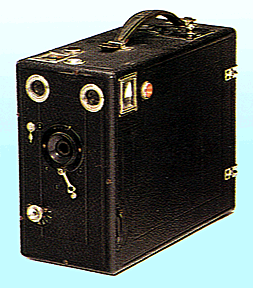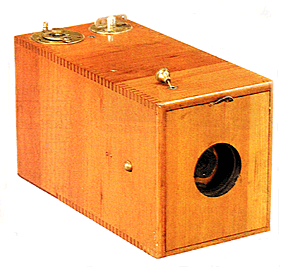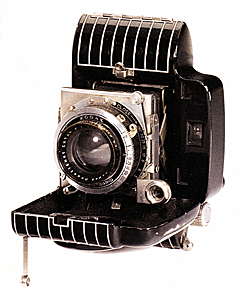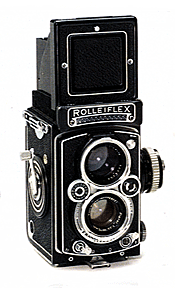 Ever since Gemma Frisius, an astronomer, took
the first photograph in 1545, people have been fascinated with recording
the world around them. Thousands of cameras have been made between 1839–the
year in which Louis Daguerre marketed the first daguerreotype–and
today. And collectors seek out the rare and not-so-rare to fill their
shelves at relatively reasonable prices.
Ever since Gemma Frisius, an astronomer, took
the first photograph in 1545, people have been fascinated with recording
the world around them. Thousands of cameras have been made between 1839–the
year in which Louis Daguerre marketed the first daguerreotype–and
today. And collectors seek out the rare and not-so-rare to fill their
shelves at relatively reasonable prices.
Plate cameras were the first photographic
devices. The photographer, most often a professional, took the image on
a metal or glass plate and each was one of a kind. There was no
negative. The period between 1839 and the middle of the 19th Century saw
the development of several kinds of plate cameras. However, by 1880 only
the tintype camera survived. Street and itinerant photographers
continued to use it as late as the 1930s. These cameras had wood frames,
with leather bellows-like bodies that could be moved back and forth on a
track to focus the picture.
 Many collectors focus on paper-film cameras.
George Eastman made the first one in 1887. His invention revolutionized
photography. Before Eastman’s invention, photography was primarily a
field for professionals. Eastman changed that by designing a simple,
inexpensive device that anyone could use. By 1901, his Kodak Brownie
sold for 25 cents. His slogan, "You press the button, we do the
rest," said it all. The novice photographer bought the film and
camera, loaded it, took the pictures, and sent the exposed film to the
Kodak factory. It came back fully developed. While this may seem
ordinary to today’s photographers, it was revolutionary back then.
Many collectors focus on paper-film cameras.
George Eastman made the first one in 1887. His invention revolutionized
photography. Before Eastman’s invention, photography was primarily a
field for professionals. Eastman changed that by designing a simple,
inexpensive device that anyone could use. By 1901, his Kodak Brownie
sold for 25 cents. His slogan, "You press the button, we do the
rest," said it all. The novice photographer bought the film and
camera, loaded it, took the pictures, and sent the exposed film to the
Kodak factory. It came back fully developed. While this may seem
ordinary to today’s photographers, it was revolutionary back then.
Eastman Kodak dominated the camera field for
generations and produced dozens of different cameras. Most clearly
associated with his name, though, is the box camera, a square or
rectangular camera made of wood, metal, leather, or, after 1930,
plastic. Beginning collectors usually buy these first, among the most
popular of these are the Brownie, as well as the Senior and Junior
Pocket Kodaks.
In 1890, Eastman marketed a folding Kodak.
Folding cameras had been around for some time. Camera manufacturers
developed them in response to the need for a compact, easily transported
photographic camera. But Eastman's was the first efficient, inexpensive
model. Among the many Eastman folding cameras, collectors seek out two
in particular–the Autographics, which produced postcard-sized shots at
a time when postcards were extremely popular, and the Art Deco-style
Bantam of the 1930s.
 Such American models notwithstanding, many
collectors also seek out the many fine European cameras. Among these,
Leicas are the favorites. The development of the 35mm camera is
associated with this firm. Following the organization of the movie
industry in the early 1900s, large quantities of 35mm movie film became
available. It wasn’t long before still-camera manufacturers decided to
take advantage of this situation. Oaskar Barnade, an employee at the
Leitz Optical Works in Wetzler, Germany, designed a metal-cased 35mm
camera in 1912, and by 1925, the company sold it commercially. Though
other companies patented four other 35mm cameras between 1912 and 1915,
including the American-made Simplex and Tourist models, Leica dominated
the field.
Such American models notwithstanding, many
collectors also seek out the many fine European cameras. Among these,
Leicas are the favorites. The development of the 35mm camera is
associated with this firm. Following the organization of the movie
industry in the early 1900s, large quantities of 35mm movie film became
available. It wasn’t long before still-camera manufacturers decided to
take advantage of this situation. Oaskar Barnade, an employee at the
Leitz Optical Works in Wetzler, Germany, designed a metal-cased 35mm
camera in 1912, and by 1925, the company sold it commercially. Though
other companies patented four other 35mm cameras between 1912 and 1915,
including the American-made Simplex and Tourist models, Leica dominated
the field.
There are many attractive American 35mm
cameras, including types produced both in the 1930s and after the
conclusion of the Second World War. Among the more attractive of these
collector's items are the Memo, made by the Ansco Company of Binghamton,
New York, and the Agfa Speedex, which dates to the 1940s.
 Most often collected by men, cameras have been
around for a long time and are a surpassingly large antique category,
considering there’s not much written about them. Antique Leitz,
Eastman Kodak, Zeiss, Leica Hassleblad and Nikon cameras often sell for
up to $10,000. Only specialist collectors know names such as Newman and
Guardia, Voigtlander Bijou, Stegemann-Berlin, and W. Kunik.
Most often collected by men, cameras have been
around for a long time and are a surpassingly large antique category,
considering there’s not much written about them. Antique Leitz,
Eastman Kodak, Zeiss, Leica Hassleblad and Nikon cameras often sell for
up to $10,000. Only specialist collectors know names such as Newman and
Guardia, Voigtlander Bijou, Stegemann-Berlin, and W. Kunik.
While some collectors specialize with a given
type of camera or concentrate on a single manufacturer, such as Eastman
Kodak or Leica, most seek a broad range of products. The bulk of the
acquisitions of such collectors fall within one of three categories:
box, folding, or 35mm. In each of these divisions the majority of the
machines found are either studio models, used by professionals, or the
more common hobby or general purpose devices sold to the general public.
There are, however, a limited number of other cameras that served
unusual purposes–detective cameras, often designed to look like books
or handbags; miniature cameras, such as the famous Minox; panoramic
cameras for photographing landscapes or large crowds; and the stereo
cameras used to produce the stereoscopic cards that were so popular
between 1880 to 1910.
Camera collecting is one category that’s easy
to get into and fun. Even older children and young adults can easily
find old cameras that cost between $10 and $20 at yard sales and flea
markets. For the serious collector, the range is quite broad, so
specializing in one particular brand or type is not only possible but
desirable.
